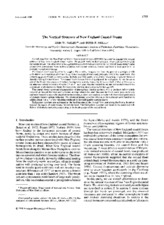| dc.creator | Nielsen, John | |
| dc.creator | Neilley, Peter | |
| dc.date.accessioned | 2016-10-28T17:13:09Z | |
| dc.date.available | 2016-10-28T17:13:09Z | |
| dc.date.issued | 1990-09-01 | |
| dc.identifier.citation | Nielsen, J. W., and P. P. Neilley, 1990: The vertical structure of New England coastal fronts. Mon. Wea. Rev., 118, 1793-1807. | en |
| dc.identifier.uri | https://hdl.handle.net/1969.1/158211 | |
| dc.description | © Copyright 1990 American Meteorological Society (AMS). Permission to use figures, tables, and brief excerpts from this work in scientific and educational works is hereby granted provided that the source is acknowledged. Any use of material in this work that is determined to be “fair use” under Section 107 of the U.S. Copyright Act September 2010 Page 2 or that satisfies the conditions specified in Section 108 of the U.S. Copyright Act (17 USC §108, as revised by P.L. 94-553) does not require the AMS’s permission. Republication, systematic reproduction, posting in electronic form, such as on a web site or in a searchable database, or other uses of this material, except as exempted by the above statement, requires written permission or a license from the AMS. Additional details are provided in the AMS Copyright Policy, available on the AMS Web site located at (https://www.ametsoc.org/) or from the AMS at 617-227-2425 or copyrights@ametsoc.org. | en |
| dc.description.abstract | Aircraft data from the New England Winter Storms Experiment (NEWSEX) are used to examine the vertical structure of four New England coastal fronts. The aircraft made multiple passes at varying elevations through the coastal fronts. The observations were projected onto cross sections normal to the coastal fronts using frontal orientations determined from surface analyses and frontal velocities determined from a least-squares fit to multiple frontal penetrations.
The frontal zones were found to be roughly 200 m wide, rising sharply from the ground to a height of 150 m to 400 m over distances of 0.5 to 2.5 km before leveling off and rising gradually toward the mountains. The underlying pools of cold air were similar in form and flow patterns to cold-air damming structures observed elsewhere along the East Coast. The coastal fronts formed the leading edges of the cold pools. Air on the warm side of the fronts was neutrally stratified, having been recently heated by the warm Gulf of Maine. This warm air attained vertical velocities of up to 2.5 m s−1 as it rose over the coastal fronts and accelerated toward the mountains, and evidence is found for direct precipitation enhancements by this updraft.
The coastal fronts possessed characteristics of atmospheric density currents, with a low-level inflow within the cold air toward the head and turbulent mixing behind the head. Because the fronts were quasi-stationary and were located in neutrally stratified environments, a direct comparison is made with theoretical predictions of inviscid density current behavior. The observed frontal velocities relative to the warm air were found to be within about 1 m s−1 of the velocities predicted by inviscid density current theory.
Richardson numbers are estimated at the leading edge of the coastal front and along the frontal inversion beyond the region of rapid mixing behind the head. The Richardson numbers are found to be consistent with Kelvin-Helmholtz instability originating at the leading edge of the coastal front. | en |
| dc.description.sponsorship | National Science Foundation | en |
| dc.publisher | American Meteorological Society | |
| dc.subject | coastal fronts | en |
| dc.subject | density currents | en |
| dc.subject | gravity currents | en |
| dc.title | The vertical structure of New England coastal fronts | en |
| dc.type | Article | en |
| local.department | Atmospheric Sciences | en |
| dc.identifier.doi | 10.1175/1520-0493(1990)118<1793:TVSONE>2.0.CO;2 | |


